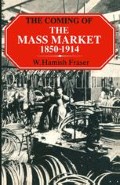Abstract
In spite of the fears of British farmers, the repeal of the Corn Laws in 1846 — a crucial victory for the manufacturing class — did not usher in the destruction of British farming. Overseas supplies of grain did not yet exist in sufficient quantity to swamp the British market. In addition growth in demand could consume what came in from abroad and a growing home supply. For a quarter of a century farming had time to adjust, and to a great extent it took the opportunities offered to it.
The sort of man who had bread and cheese for his dinner forty years ago now demands a chop.
F. A. Graham, The Revival of English Agriculture (1899).
Preview
Unable to display preview. Download preview PDF.
Notes and References
J. H. Clapham, An Economic History of Modern Britain (Cambridge, 1963) vol. II, p. 277.
Quoted in G. E. Mingay, Rural Life in Victorian England (1976) p. 21.
B. R. Mitchell and P. Deane, Abstract of British Historical Statistics (Cambridge, 1962) p. 224.
S. Smith M. P., quoted in E. E. Williams, The Foreigner in the Farmyard (1897) p. 123.
Daily Mail Year Book (1906); W. E. Bear, ‘The Food Supply of Manchester — Part III. Journal of the Royal Agricultural Statistical Society of England, 3rd ser. x (1899) 32–3.
W. E. Bear, ‘The Food Supply of Manchester — Part I, Journal of the Royal Agricultural Statistical Society of England, 3rd ser. VIII (1897) 223.
E. Brown, ‘The Marketing of Poultry’, Journal of the Royal Agricultural Statistical Society of England, 3rd ser., IX (1898) p. 276.
S. G. Hanson, Argentine Meat and the British Market (Stanford, 1938) p. 18.
J. T. Critchell and J. Raymond, A History of the Frozen Food Trade (1912) p. 423.
D. Taylor, ‘The English Dairy Industry, 1860–1930’, Economic History Review, 2nd ser. XXIX (1976) 591.
G. E. Fussell, The English Dairy Farmer (1966) pp. 290–4.
E. H. Whetham, ‘The London Milk Trade, 1860–1900’, Economic History Review, XVII (1964) 369–80.
Fussell, The English Dairy Farmer, pp. 312–3; E. H. Whetham, ‘The London Milk Trade, 1900–1930’ in D. J. Oddy and D. S. Miller (eds), The Making of the Modern British Diet (1976) p. 67.
H. A. MacEwan, The Public Milk Supply (Glasgow, 1910) p. 39.
J. C. Drummond and A. Wilbraham, The Englishman’s Food (1957), p. 303.
W. H. Beable, The Romance of Great Businesses (1926) pp. 209–10
A. Jenkins, Drink a Pinta (1970) p. 58.
E. E. Williams, Made in Germany (1896) p. 65.
J. H. Van Stuyvenburg, Margarine: An Economic Social and Scientific History (Liverpool, 1959).
Bear, ‘The Food Supply of Manchester — Part II, Journal of the Royal Agricultural Statistical Society of England, 3rd, ser. VIII (1897) 512.
J. Dyson, Business in Great Waters (1977) pp. 58–9.
C. L. Cutting, Fish Saving: A History of Fish Processing from Ancient to Modern Times (1955) pp. 233–4.
Cutting, Fish Saving, p. 299; J. Blackman, ‘The Food Supply of an Industrial Town: A Study of Sheffield’s Public Markets, 1780–1900’, Business History, v (1962–3) 94.
F. G. Aflalo, The Sea-Fishing Industry of England and Wales (1904) p. 341.
J. J. Manley, ‘Preservation of Food’, in G. P. Bevan (ed.), British Manufacturing Industries, vol II (1876) p. 59.
Henry Mayhew, Shops and Companies of London (1865) p. 59.
E. H. Taylor, The Story of Preserved Foods (Newcastle-upon-Tyne, 1921).
J. Burnett, Plenty and Want (1968) p. 160.
G. Dodd, The Food of London (1856) p. 195.
J. Burnett, ‘The Baking Industry in the Nineteenth Century’, Business History, v (1962) 101.
C. Booth, Life and Labour of the People in London: Industry, III, 2nd ser. (1903) p. 155.
R. Q. Gray, The Labour Aristocracy in Victorian Edinburgh (1976) p. 28.
P. Mathias, Retailing Revolution (1967) pp. 312–16.
T. A. B. Corley, Quaker Enterprise in Biscuits (1972) p. 66.
J. S. Adams, A Fell Fine Baker: The Story of United Biscuits (1974) p. 12.
F. Lewis, Essex and Sugar (1976).
N. Deer, The History of Sugar (1950).
D. Forrest, Tea for the British: The Social and Economic History of a Famous Trade (1973) p. 189.
Henry Mayhew, Shops and Companies of London (1865) pp. 174–6.
F. A. Mackenzie, The American Invaders (1902) p. 57.
C. B. Hawkins, Norwich, a Social Study (1910) p. 17.
M. F. Davies, Life in an English Village (1909) p. 197
B. S. Rowntree and M. Kendall, How the Labourer Lives: A Study of the Rural Labour Problem (1913) p. 44.
P. Thompson, The Edwardians (1975) p. 180.
Copyright information
© 1981 W. Hamish Fraser
About this chapter
Cite this chapter
Fraser, W.H. (1981). The Nation Fed. In: The Coming of the Mass Market, 1850–1914. Palgrave, London. https://doi.org/10.1007/978-1-349-16685-5_11
Download citation
DOI: https://doi.org/10.1007/978-1-349-16685-5_11
Publisher Name: Palgrave, London
Print ISBN: 978-0-333-31034-2
Online ISBN: 978-1-349-16685-5
eBook Packages: Palgrave Economics & Finance CollectionEconomics and Finance (R0)

